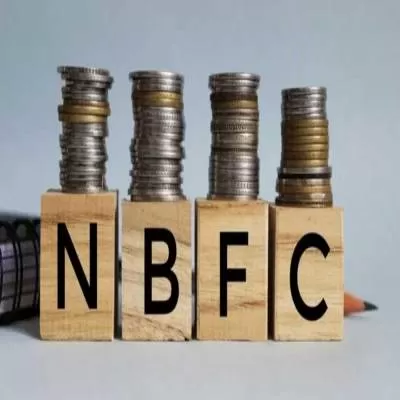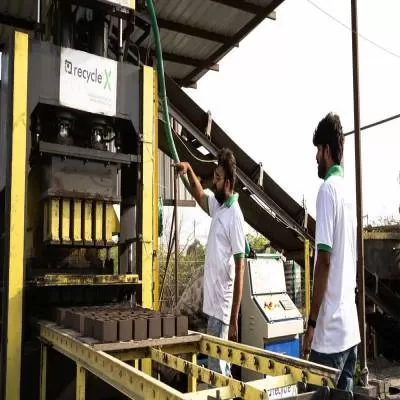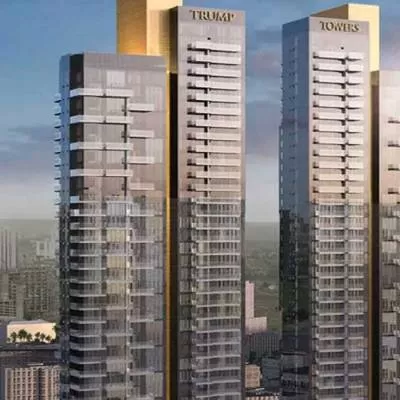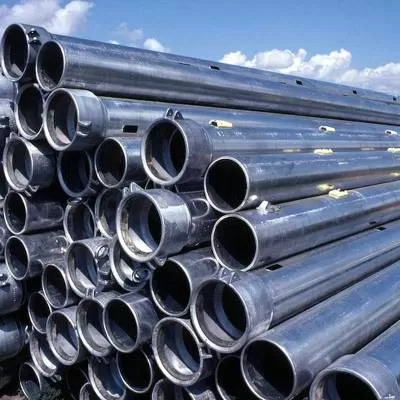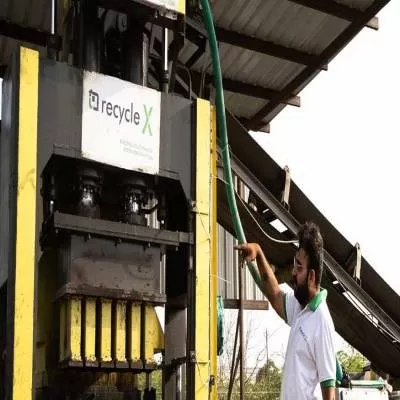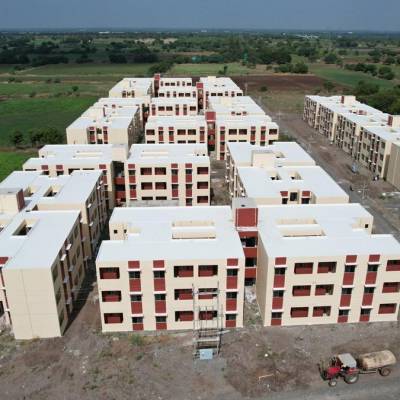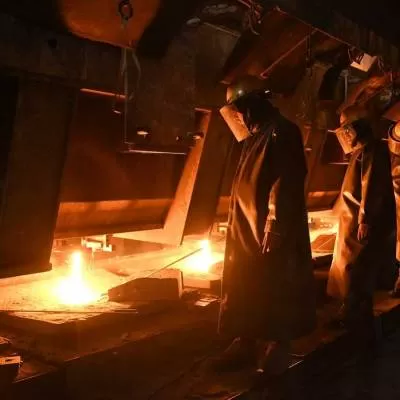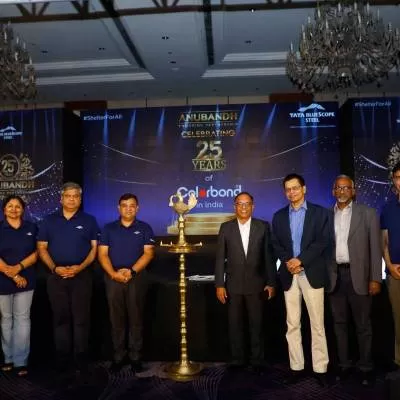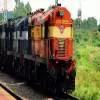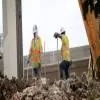- Home
- Building Material
- Steel
- Steel for All

Steel for All
Affordable housing is still a major concern in India as it urgently needs to provide economical housing in the shortest timeframe. While the selection of construction technology and material should satisfy aspects such as ease of construction and lower cost, it is equally important to ensure sustainability. In an effort to provide quality, affordable housing in the shortest possible time, Prof Mahendrakumar Madhavan, Faculty-Civil Engineering, IIT Hyderabad, has been researching to arrive at cost-effective sustainable solutions using cold-formed steel (CFS). He shares more on CFS, its advantages, and the need for India to build right with CW.
CFS and its application: A type of steel, CFS is a thin rolled sheet, which is run through cold rolled mills. Initially in the form of a coil, it is sent through a series of rollers to produce several structural shapes and sizes, unlike hot rolled steel, which is manufactured using billets. For installation, a fibre or gypsum sheathing is connected to the CFS structural member with self-tapping screws resulting in a formation of a wall panel. Inside this panel, rockwool or other insulating materials can be placed for thermal comfort. It is similar to the timber framed houses constructed in the US. CFS is thin, flexible, lightweight, and significantly helps in reducing the cost of construction. This lightweight steel is best suitable for affordable housing; in urban housing, to build up to five floors. With a slab cycle of two to three days for one floor, it can also be achieved in a day or two with skilled labour and equipment operators, which are currently lacking. Further, IIT Hyderabad is carrying out research to identify the optimal shape and geometry of the cross-section to make CFS more effective for load bearing. CFS for disaster-prone regions: While it is flexible, and manufactured and disassembled off site, it can be quickly assembled and installed on-site, making it ideal for use in disaster or earthquake-prone areas. Conventional structures are heavy, and most structures are primarily designed for vertical or gravity load with little attention being paid for lateral load resistance û earthquake, tsunami or wind. This is because such proper detailing leads to increase in cost, and India is still not adaptive to new methods. India´s seismic map is changing; the country has experienced earthquake several times over the last decade. In addition, the frequent occurrence of cyclone has only been a proof of the vulnerability of our present housing stock, which is primarily constructed using unreinforced masonry and concrete. There needs to be a paradigm shift from using an unsustainable (one that is difficult to be reused at its native strength) and brittle material such as masonry and concrete to using structural steel as a material of choice for construction. Also, instead of looking at the initial cost, which may be higher, one should consider the life-cycle cost. Besides, if the structure has to be relocated in future, it will result in significant savings as the material can be reused. In addition to a reduced carbon footprint, this makes the salvage value of the steel intensive structure high, as the material can be designed at its native strength with no loss due to ageing. Several school buildings and anganwadis in the Northeast are using CFS. This is also suitable in hilly areas where transporting cement, concrete and other materials to higher altitudes is challenging.
Advantages and shortcomings: CFS is a green material, which means it can be reused at the same native strength at which it was produced.
It is innovative and flexible as it can be rolled in to desired shapes. Being light in weight, it is easily transportable. In pre-engineered buildings (PEBs) too, it can be used as purlins to support the roof cladding and as girts to support the wall cladding. Here, CFS purlins and girts act as a secondary member. Several green-rated structures too use components of CFS. A huge challenge lies in creating awareness regarding the choice of material to be used for construction especially in coastal areas and areas where the risk of seismic activity is high (Zone V). Typically a ôone size fits allö approach is adopted and a wrong choice of using concrete is made considering that the initial cost of steel is more. Also, home owners spend a huge amount on non-structural elements like false ceiling, tiles, bathroom fittings, etc, but skimp when it comes to structural applications. Therefore, a paradigm shift in mindset - from a concrete to a steel intensive structure - is needed to ensure wind and earthquake resistance, etc. Another challenge is lack of skilled labour; training is crucial to use such innovative technologies and materials.
Lack of robust design procedure: Houses cannot be built and then recalled; thus, extensive testing is required, which would enable introducing our own design specifications that could work in Indian conditions. Thereafter, these can be incorporated in the building codes. Currently, there is lack of consistency in the design and implementation of new technologies such as CFS. Indian products are designed using foreign design specifications for CFS. Typically, both the product and the design specification should go together. Hence, for adoption of CFS technology there is an urgent need in India to create a design procedure, test it, collect data, create guidelines and incorporate them in building codes. Further, we need to take advantage of faster construction techniques for which we need to adopt a sound technology, have a strategic mission and choose the right materials.
The way forward: In China, manufacturing and even building the floors - HVAC duct, electrical wiring, light fitting, etc - happen in the factory. The final product is only lifted, placed and bolted on site. Thus, they are able to do two to three floors a day. For India to adopt such technologies and materials as CFS, there is a need to evaluate the choice of materials, labour cost, maintenance cost, RoI, salvage value, whether it is green and economical, whether we have enough sand to build, and the quality of construction.
Cost Comparison
Concrete: Rs.1,400 per sq ft ? over Rs.4 lakh for a 300-sq-ft building.
Cold-formed steel: about Rs.670 per sq ft ? about Rs.2 lakh for a 300-sq-ft building.
SERAPHINA D´SOUZA
Share an innovative material at feedback@ConstructionWorld.in
Cold-formed steel, a cost-effective and sustainable material, can soon make 'Housing for All' a reality. Affordable housing is still a major concern in India as it urgently needs to provide economical housing in the shortest timeframe. While the selection of construction technology and material should satisfy aspects such as ease of construction and lower cost, it is equally important to ensure sustainability. In an effort to provide quality, affordable housing in the shortest possible time, Prof Mahendrakumar Madhavan, Faculty-Civil Engineering, IIT Hyderabad, has been researching to arrive at cost-effective sustainable solutions using cold-formed steel (CFS). He shares more on CFS, its advantages, and the need for India to build right with CW. CFS and its application: A type of steel, CFS is a thin rolled sheet, which is run through cold rolled mills. Initially in the form of a coil, it is sent through a series of rollers to produce several structural shapes and sizes, unlike hot rolled steel, which is manufactured using billets. For installation, a fibre or gypsum sheathing is connected to the CFS structural member with self-tapping screws resulting in a formation of a wall panel. Inside this panel, rockwool or other insulating materials can be placed for thermal comfort. It is similar to the timber framed houses constructed in the US. CFS is thin, flexible, lightweight, and significantly helps in reducing the cost of construction. This lightweight steel is best suitable for affordable housing; in urban housing, to build up to five floors. With a slab cycle of two to three days for one floor, it can also be achieved in a day or two with skilled labour and equipment operators, which are currently lacking. Further, IIT Hyderabad is carrying out research to identify the optimal shape and geometry of the cross-section to make CFS more effective for load bearing. CFS for disaster-prone regions: While it is flexible, and manufactured and disassembled off site, it can be quickly assembled and installed on-site, making it ideal for use in disaster or earthquake-prone areas. Conventional structures are heavy, and most structures are primarily designed for vertical or gravity load with little attention being paid for lateral load resistance û earthquake, tsunami or wind. This is because such proper detailing leads to increase in cost, and India is still not adaptive to new methods. India´s seismic map is changing; the country has experienced earthquake several times over the last decade. In addition, the frequent occurrence of cyclone has only been a proof of the vulnerability of our present housing stock, which is primarily constructed using unreinforced masonry and concrete. There needs to be a paradigm shift from using an unsustainable (one that is difficult to be reused at its native strength) and brittle material such as masonry and concrete to using structural steel as a material of choice for construction. Also, instead of looking at the initial cost, which may be higher, one should consider the life-cycle cost. Besides, if the structure has to be relocated in future, it will result in significant savings as the material can be reused. In addition to a reduced carbon footprint, this makes the salvage value of the steel intensive structure high, as the material can be designed at its native strength with no loss due to ageing. Several school buildings and anganwadis in the Northeast are using CFS. This is also suitable in hilly areas where transporting cement, concrete and other materials to higher altitudes is challenging. Advantages and shortcomings: CFS is a green material, which means it can be reused at the same native strength at which it was produced. It is innovative and flexible as it can be rolled in to desired shapes. Being light in weight, it is easily transportable. In pre-engineered buildings (PEBs) too, it can be used as purlins to support the roof cladding and as girts to support the wall cladding. Here, CFS purlins and girts act as a secondary member. Several green-rated structures too use components of CFS. A huge challenge lies in creating awareness regarding the choice of material to be used for construction especially in coastal areas and areas where the risk of seismic activity is high (Zone V). Typically a ôone size fits allö approach is adopted and a wrong choice of using concrete is made considering that the initial cost of steel is more. Also, home owners spend a huge amount on non-structural elements like false ceiling, tiles, bathroom fittings, etc, but skimp when it comes to structural applications. Therefore, a paradigm shift in mindset - from a concrete to a steel intensive structure - is needed to ensure wind and earthquake resistance, etc. Another challenge is lack of skilled labour; training is crucial to use such innovative technologies and materials. Lack of robust design procedure: Houses cannot be built and then recalled; thus, extensive testing is required, which would enable introducing our own design specifications that could work in Indian conditions. Thereafter, these can be incorporated in the building codes. Currently, there is lack of consistency in the design and implementation of new technologies such as CFS. Indian products are designed using foreign design specifications for CFS. Typically, both the product and the design specification should go together. Hence, for adoption of CFS technology there is an urgent need in India to create a design procedure, test it, collect data, create guidelines and incorporate them in building codes. Further, we need to take advantage of faster construction techniques for which we need to adopt a sound technology, have a strategic mission and choose the right materials. The way forward: In China, manufacturing and even building the floors - HVAC duct, electrical wiring, light fitting, etc - happen in the factory. The final product is only lifted, placed and bolted on site. Thus, they are able to do two to three floors a day. For India to adopt such technologies and materials as CFS, there is a need to evaluate the choice of materials, labour cost, maintenance cost, RoI, salvage value, whether it is green and economical, whether we have enough sand to build, and the quality of construction. Cost Comparison Concrete: Rs.1,400 per sq ft ? over Rs.4 lakh for a 300-sq-ft building. Cold-formed steel: about Rs.670 per sq ft ? about Rs.2 lakh for a 300-sq-ft building. SERAPHINA D´SOUZA Share an innovative material at feedback@ConstructionWorld.in


